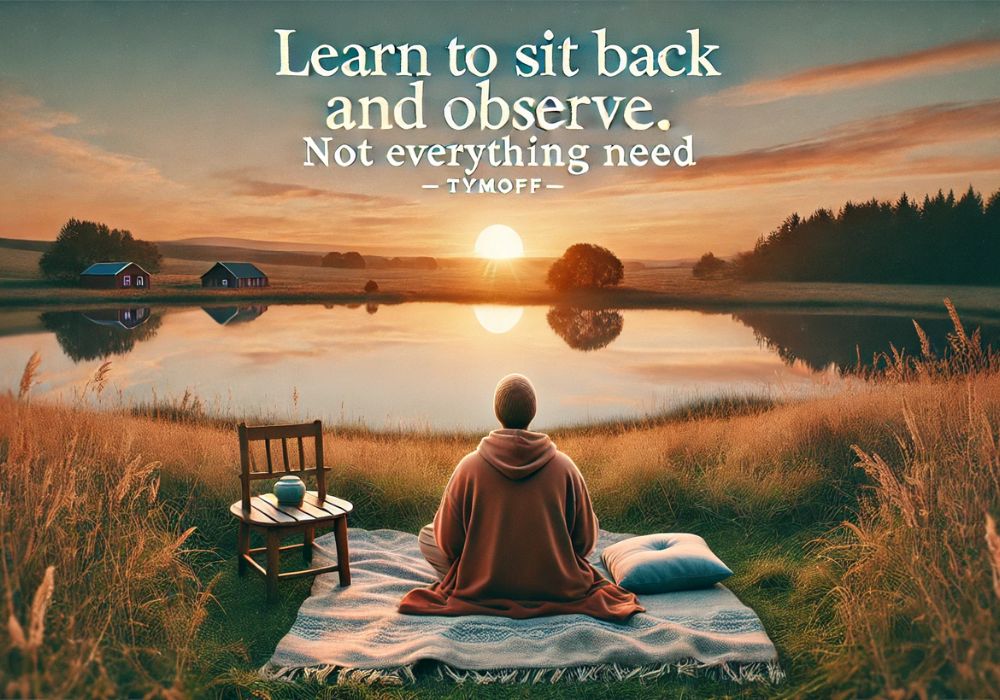Introduction
Overview of the Concept of Mindfulness and Observation
Mindfulness and observation are crucial components of a balanced life. Mindfulness means being fully present in the moment, aware of where we are and what we’re doing, without becoming overly reactive or overwhelmed by what’s going on around us. This concept is not just a practice but a way of living that helps individuals understand their environments and personal experiences more deeply. It’s like having a mental camera that captures the nuances of our daily lives, teaching us to respond more thoughtfully to situations.
Brief Introduction to the Phrase and Its Relevance
The phrase “learn to sit back and observe, not everything needs a reaction,” captures the essence of choosing observation over immediate response. This advice is particularly pertinent in today’s fast-paced world where stress and quick decisions can lead to unnecessary conflicts and anxiety. By adopting this approach, we learn to conserve our emotional energy and deploy it where it truly matters, which not only enhances our decision-making but also improves our mental health. Observing doesn’t mean disengaging from life; rather, it allows us to experience life more fully, with a clearer mind and a calmer heart.
Through my own journey, I’ve found immense value in stepping back and observing rather than jumping into every issue that comes my way. It’s like watching a bustling street from a quiet café; you see the rush and the chaos, but you remain at peace, unswayed by the commotion. This practice has not only given me greater peace but also heightened my appreciation for the quieter moments that I might have otherwise missed. This perspective is not just personal but is supported by numerous studies highlighting the benefits of mindfulness and observation in enhancing emotional intelligence and decision-making.
The Importance of Observation
Understanding Observation: Define what it means to “sit back and observe”
Observation is more than just looking at things—it’s about truly seeing what’s in front of you and understanding the context. To “sit back and observe” means to take a step back from immediate reactions and to view situations with patience and mindfulness. This practice isn’t about inaction; rather, it’s a deliberate choice to understand the full spectrum of a situation before responding. It’s like watching a bustling street from a quiet café, noticing the rhythms and interactions without getting swept away by the noise.
Benefits of Observation in Daily Life: How observation can lead to better decisions and reduced stress
Incorporating observation into daily life can transform how we make decisions and manage stress. For instance, by observing how different tasks affect your mood and productivity, you can better organize your day to maximize efficiency and minimize frustration. It’s akin to a gardener watching how the sun sweeps across their garden; they learn which plants thrive in the shade and which need more light. Similarly, by observing your reactions to small daily events, you can learn to anticipate stressors and handle them with ease, keeping your mental space clear and focused. This proactive approach not only smooths out the day-to-day challenges but also enhances your overall well-being by fostering a calm, informed perspective on life’s ups and downs.
Each of these elements not only enriches your personal experiences but also equips you with the tools to handle complex situations with a clear head, ultimately leading to a more thoughtful, productive, and stress-free lifestyle.
Cultural Influence on the Concept of Observation
Eastern vs. Western Perspectives
The way we perceive and value observation varies widely between Eastern and Western cultures, reflecting deep-rooted philosophical traditions. In the East, particularly in traditions like Buddhism and Taoism, observing without immediate reaction is often seen as a path to enlightenment. This approach emphasizes the value of silence and patience, encouraging individuals to understand the flow of life before engaging with it. Western thought, influenced by the Greek philosophical tradition and later by the scientific revolution, often values immediate analysis and action, viewing observation as a preliminary step to problem-solving.
Historical Context
Tracing the origins of the philosophy of observation reveals a rich tapestry of thought influenced by numerous cultures and epochs. Ancient Indian scriptures like the Vedas incorporate practices of meditation that emphasize the observer role, suggesting a historical precedence for reflective observation. Similarly, classical Greek philosophers such as Socrates advocated for a reflective life, suggesting that deep observation leads to a truer understanding of reality. Over time, these philosophies have evolved but continue to influence contemporary practices in both personal and professional spheres.
Personal Experience
From my own experience, integrating observation into daily life has opened up new ways of understanding the world. Living in a bustling city, I’ve learned to observe the rhythm of life around me without feeling the need to react to every single event. This practice has not only reduced stress but has also enhanced my interactions with others, allowing for deeper connections and insights. By observing, I gather nuances and contexts that would otherwise be missed in the rush of immediate reaction.
Psychological Perspective on Observation
Cognitive Benefits: How Observation Affects the Brain
Observation is not just about seeing; it’s a way to enhance our brain’s ability to process information more efficiently. When we sit back and observe, we give our minds the space to absorb details without the clutter of immediate reactions. This practice can lead to improved memory and sharper focus. From my own experience, adopting a routine of mindful observation before starting work has significantly boosted my concentration levels throughout the day. This approach encourages our cognitive functions to operate in a more connected and extensive network, enhancing our overall mental agility.
Emotional Intelligence: Link Between Observation and Understanding Emotions
Understanding emotions—both our own and others’—is deeply rooted in our ability to observe without immediate judgment. Observing allows us to recognize the subtleties of emotional responses that might go unnoticed in the heat of the moment. For instance, by reflecting on interactions with a friend who seemed off, I realized that their brief pauses and sighs were signs of stress, not disinterest. This realization helped me respond more empathetically. Developing this skill can transform relationships and foster a deeper connection with others, as it equips us with the tools to respond not just to what is said, but to the unspoken feelings behind the words.
Through observation, we gain a clearer understanding of the world around us and our place within it. This skill is essential, allowing us to navigate social interactions and personal challenges more effectively. Each moment of observation adds a layer of knowledge and understanding, enriching our emotional landscape and enhancing our ability to engage with the world in a mindful, informed manner.
Practical Tips on Implementing Observation
When to React vs. When to Observe: Guidelines for Choosing Observation Over Action Deciding when to step back rather than stepping in is crucial. In my experience, observation is key during conflicts or when emotions run high. It allows one to assess the situation calmly and respond more thoughtfully. For instance, if a colleague is venting frustration, instead of immediately offering advice or a solution, simply listening can be more beneficial. This practice not only helps in understanding the context fully but also in crafting a response that is insightful and constructive, rather than reactive.
Techniques for Better Observation: Mindfulness Exercises, Journaling, etc. Enhancing your observation skills can be straightforward with techniques like mindfulness and journaling. Mindfulness exercises such as focused breathing or mindful walking encourage presence and awareness, allowing you to notice more about your environment and interpersonal interactions. Journaling, on the other hand, can be a reflective practice where you record daily events and your reactions to them. This helps in recognizing patterns in your behavior and modifying them as needed. Over time, these techniques foster a deeper engagement with your surroundings and a clearer understanding of your own responses.
Each technique not only sharpens your ability to observe but also deepens your relationship with your environment and those within it. By practicing these methods, you can improve your attentiveness and ability to engage with the world in a more reflective and meaningful way.
Case Studies and Real-Life Examples
Personal Success Stories: Examples of individuals who benefited from this practice
Sarah works with computers. She tried a new way to help her team. Instead of just doing things quickly, she watched and listened more. This helped her see problems better and fix them faster. Her team got a lot better because she took time to understand.
Professional Context: How observation can lead to success in the workplace
Mr. Thompson is a school boss. He started to watch classes quietly to see how teachers and students do their work. By looking and not just jumping in, he found ways to help teachers teach better. This made students learn more and everyone liked school more. Watching carefully helped Mr. Thompson make school a better place for everyone.
Challenges and Misconceptions
Common Challenges
Learning to just watch and not always do something can be hard. We often think we need to stay busy all the time. When we try to just watch, we might feel like we are missing out or wasting time. It’s also hard to not jump in when something happens. We might feel like we have to react right away, especially when we are upset or excited.
Addressing Misconceptions
Some people think that if you just watch and not do, it means you don’t care or you’re not doing anything important. But that’s not true. Watching carefully helps us decide when it’s a good time to act and when it’s better to think more before we act. Watching helps us understand things better. When we understand things better, we can make smarter choices.
When we practice watching more and reacting less, we need to be patient. It takes time to get good at it. Joining a group or class that teaches about watching and thinking can help. It’s a good skill to learn because it helps us handle things better as they come up.

